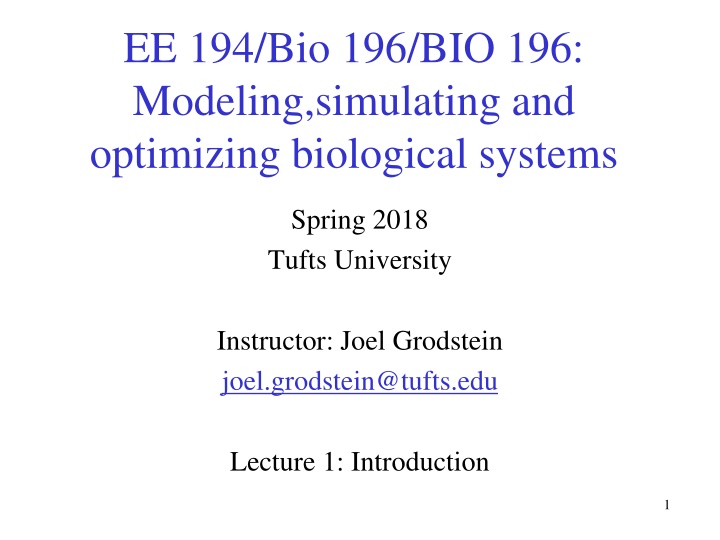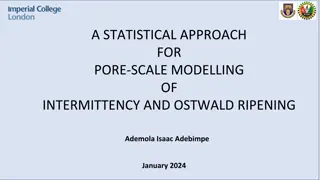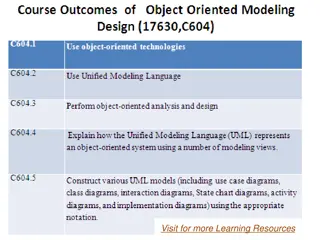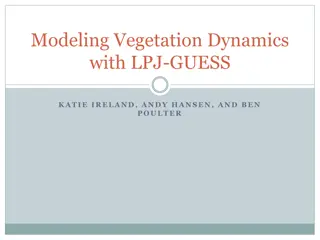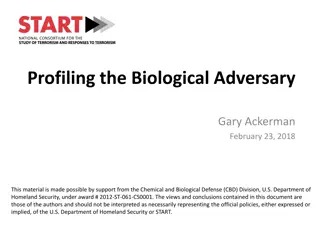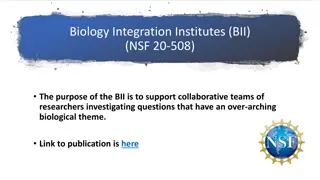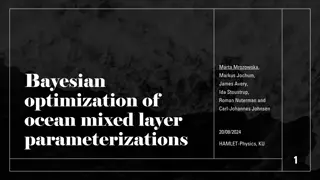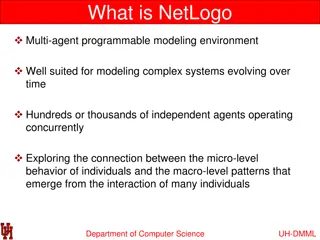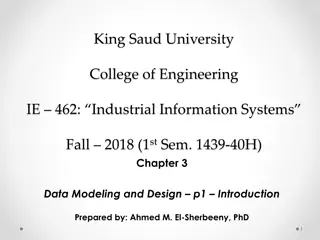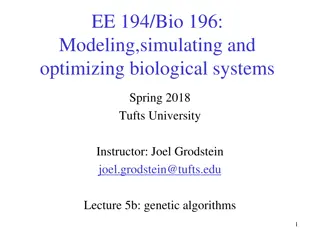Modeling, Simulating, and Optimizing Biological Systems - Course Introduction
This course introduces the concepts of modeling, simulating, and optimizing biological systems. It covers how to build computer programs to simulate real systems, run models with different parameters, and find optimal solutions to achieve specific goals. The instructor, Joel Grodstein, emphasizes the interdisciplinary nature of the course, bridging biology and engineering. The potential for impactful collaborations and the importance of working in interdisciplinary teams are highlighted. Students are encouraged to embrace the quantitative aspects of biology and improve their programming skills.
Download Presentation

Please find below an Image/Link to download the presentation.
The content on the website is provided AS IS for your information and personal use only. It may not be sold, licensed, or shared on other websites without obtaining consent from the author.If you encounter any issues during the download, it is possible that the publisher has removed the file from their server.
You are allowed to download the files provided on this website for personal or commercial use, subject to the condition that they are used lawfully. All files are the property of their respective owners.
The content on the website is provided AS IS for your information and personal use only. It may not be sold, licensed, or shared on other websites without obtaining consent from the author.
E N D
Presentation Transcript
EE 194/Bio 196/BIO 196: Modeling,simulating and optimizing biological systems Spring 2018 Tufts University Instructor: Joel Grodstein joel.grodstein@tufts.edu Lecture 1: Introduction 1
Big title: modeling, simulating and optimizing biological systems It s a new class. So, what do you think the course is about? What do you want it to be about? EE 194/Bio 196 Joel Grodstein 2
What it means Modeling building (in our case) a computer program to use instead of the real system Simulating: run the model (often with different parameters) to see what it predicts example: model a population, and change the food supply Optimizing Find the parameters that best achieve some goal E.g., what management strategy makes the population grow best There may be a lot of choices! EE 194/Bio 196 Joel Grodstein 3
Why do we care about models? Sometimes the real-life system is unavailable to experiment with William Sellers, Leeds University, "Investigating the running abilities of Tyrannosaurus rex using stress- constrained multibody dynamic analysis" https://www.youtube.com/watch?v=rxqHVoZ0fzc Conclusion: T.Rex max speed was about 12mph Can you think of other systems that are difficult to work with? EE 194/Bio 196 Joel Grodstein 4
Instructor & TA Instructor: Joel Grodstein Office Hours: Monday/Wednesday 2-3pm (i.e., before class), or email for an appointment Halligan extension room 11 My Background 30 years in the computer industry My 2nd semester as official ECE faculty First time I've ever taught a "biology" course TA: Cassandra Donatelli 5
Why would we want EE faculty to teach a biology course, anyway? This is not only a biology course. The world is becoming more and more interdisciplinary Interesting problems are becoming hard enough that no one discipline can be an island any more For the biologists: The world is becoming more quantitative Programming is a very useful job skill For the engineers: mix of biology and engineering has lots of potential to change the future Making interdisciplinary teams work is really hard (but fun): Everyone has to at least speak the same language Bio PhDs will definitely know more about their area than I will Please have fun correcting my biology mistakes Learning to live (and thrive) in that environment is part of working on an interdisciplinary team EE 194/Bio 196 Joel Grodstein 6
Course web page http://www.ece.tufts.edu/ee/194MSO/ Syllabus, calendar Lecture foils, HWs EE 194/Bio 196 Joel Grodstein 7
Course speed It's a new course It's not clear how quickly we should cover material, or in what depth Not bound by any requirements other than to learn as much as is reasonable for the large majority of people Grades will work out fine in the end Request: let me know if we're moving too fast or slow.. we will try to adjust the pace as needed We can remove homeworks or topics if needed Each HW has an extra-credit problem Office hours are meant to be used EE 194/Bio 196 Joel Grodstein 8
Population modeling What we'll learn about biology lx-mx models What we'll learn about modeling Simulating models GIGO stochastic models Using models for things we cannot easily measure (desert tortoises) What we'll learn about programming the basics: variables, loops, if/then, arrays 2-3 homeworks EE 194/Bio 196 Joel Grodstein 9
Kinetic proofreading What we'll learn about biology How the body discriminates between closely-related molecules What we'll learn about modeling & optimization Exhaustive algorithms try absolutely everything and still finish before dinner Using a pre-existing framework What we'll learn about programming multiply-nested loops, user-defined functions 1 HW EE 194/Bio 196 Joel Grodstein 10
Manduca sexta What we'll learn about biology How M.sexta crawls What we'll learn about modeling Genetic algorithms; running evolution at computer speed to evolve better solutions to problems Models can give us new insights about our system even (especially) when they re wrong Optimization and visualization can give us new insights about our models What we'll learn about programming Object-oriented programming 1 long HW EE 194/Bio 196 Joel Grodstein 11
Bacterial chemotaxis What we'll learn about biology How bacteria create goal-directed movement with simple chemical reactions How bacteria use memory circuits to help them get to their goal What we'll learn about modeling top-down vs. bottom-up modeling What we'll learn about programming Practice, practice and 1 HW EE 194/Bio 196 Joel Grodstein 12
Bioelectricity What we'll learn about biology What is bioelectricity, and how is it part of morphogenesis What we'll learn about modeling A framework to model bioelectricity More on top-down vs. bottom-up modeling What we'll learn about programming Still more practice, and 1 HW EE 194/Bio 196 Joel Grodstein 13
Math Differential equations are part of modeling We're not going to make everyone into math majors We're not going to try But differential equations are very common in models We want to understand intuitively what a differential equation is, and what it means We want you to not be scared when people talk about them We're not going to solve them ourselves EE 194/Bio 196 Joel Grodstein 14
Python Why learn a computer language? It's becoming a more and more valuable job skill A one-semester intro will not make you a CS major But we will teach you to write small programs, read other people's programs, and not be scared of them Give you the tools to learn more, and the exposure to see if you like it Why Python? Easy to learn and still quite powerful At or near the top in most language-popularity surveys It has a nice interface to GIS (Geographic Information System). Named after a British comedy series & movie EE 194/Bio 196 Joel Grodstein 15
Recitation session Programming will be a challenge Like any language, you learn by doing Weekly recitation, in Halligan PC lab, for help with the programming HW What times work best? Before class Tues? Before class Thurs? Other? EE 194/Bio 196 Joel Grodstein 16
From xkcd Perhaps almost nobody gets it? Guarantee: by the end of the course you'll get this cartoon It may still not be funny, though EE 194/Bio 196 Joel Grodstein 17
Learning to program Learning any new language takes time and effort Not something you can cram for just daily practice A physicist is looking for the truth. An engineer just wants to build something. Sten Graff Larsen Programming and modeling make it easy to make stuff 18
Expectations (will likely change) About 6 programming assignments (75%) A few quizzes (15%) Class participation (10%) Perhaps a final project Take a problem and take it further Work in teams to get more done; will hopefully allocate the last 2 weeks of class Present during final-exam slot EE 194/Bio 196 Joel Grodstein 19
First modeling issue A road map is a model. It is a representation of, e.g., Boston We don't really use it for simulation or optimization, but we still do useful things with it Question: what scale of map is most useful? OK, Google maps lets you scale in and out dynamically But what scale is most useful for a paper map? Too detailed, and the map is unwieldy Too abstract, and it's almost useless EE 194/Bio 196 Joel Grodstein 20
Too precise What do you consider the largest map that would be really useful? About six inches to the mile. Only six inches! exclaimed Mein Herr. We very soon got to six yards to the mile. Then we tried a hundred yards to the mile. And then came the grandest idea of all! We actually made a map of the country, on the scale of a mile to the mile! Have you used it much? I enquired. It has never been spread out, yet, said Mein Herr: the farmers objected: they said it would cover the whole country, and shut out the sunlight! So we now use the country itself, as its own map, and I assure you it does nearly as well. From Sylvie and Bruno (Lewis Carroll) EE 194/Bio 196 Joel Grodstein 21
The other extreme The Bellman's map, from The hunting of the snark (Lewis Carroll again) https://people.duke.edu/~ng46/topics/lewis-carroll.htm Takeaway: "No model is correct. Some are still useful," George Box Art is a lie that helps us to see the truth, Picasso Choosing the most useful level of detail for a model is rarely easy Making the model unwieldy or inaccurate is all too easy Especially since we're often modeling systems that we don't really understand EE 194/Bio 196 Joel Grodstein 22
Questions? EE 194/Bio 196 Joel Grodstein 23
